"I don't think I was a particularly good architect," says NY lighting designer Bec Brittain
New York 2015: in the latest in our series of interviews with leading New York designers, Bec Brittain explains why she studied philosophy and architecture before turning to lighting (+ slideshow + transcript).
"I like the fact that I can be more obsessive with detail on this scale," said Brittain, who is one of the brightest talents in the city's vibrant lighting design scene. "I prefer dealing with space on a smaller scale. I don't think I was a particularly good architect."
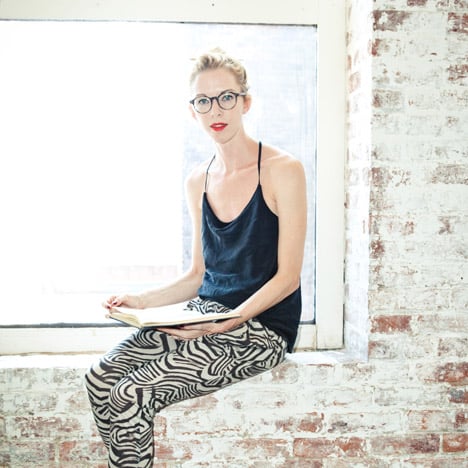
However, her education could explain why her lighting has a strong architectural quality, being more angular and technical-looking than the work of many of her New York peers.
Her breakout piece was the 2011 modular Shy light – an angular space-frame of thin LED tubes and metal fittings. "That was the product that started the business. It was a simple thought I had of wanting to draw with lines of light – of just being as spare as possible," she said.
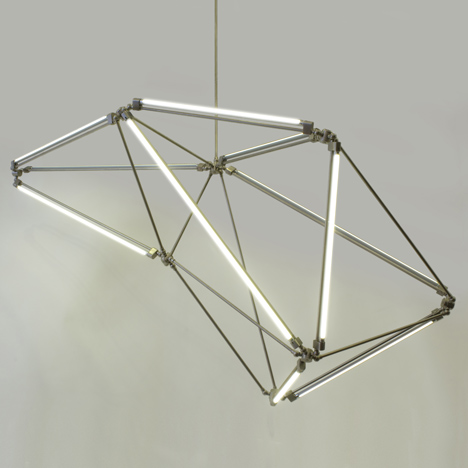
Brittain, 34, came to lighting via what she describes as a "windy route". She started out on a product design course at Parsons School of Design but found it didn't suit her.
"I didn't really know why I wanted to make things," she said in an interview with Dezeen at the International Contemporary Furniture Fair in New York earlier this month. "I didn't just want to mass produce stuff for the sake of mass producing stuff."
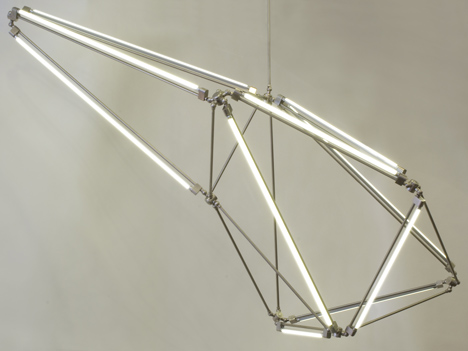
Instead she studied philosophy at New York University and then architecture at the Architectural Association in London before heading back home to work at architecture studio WorkAC.
After a year or so she switched direction again, ending up as a design director for New York's premier lighting designer Lindsey Adelman.
"With architecture, you have to let go of a layer of detail at some point because you have subcontractors," she said, explaining the career switch. "I like the fact that I can be more obsessive with detail on this scale. It's more pragmatic. If you were that obsessive with architecture, you would never get anything built."
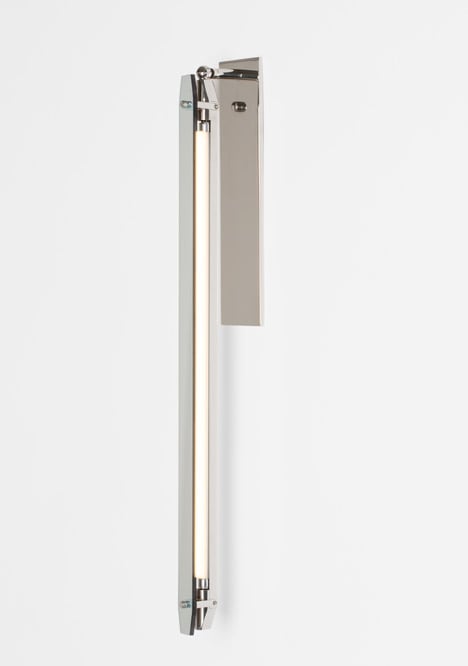
However she denies being a control freak, saying: "I'm not a control freak in the way that I understand that perfect doesn't exist."
Brittain set up her own studio in 2011, quickly generating widespread acclaim and a roster of international clients. She now has six employees.
Like Adelman, David Weeks, and many other prominent New York lighting designers, she uses locally produced components that her team assembles by hand to create the finished products.
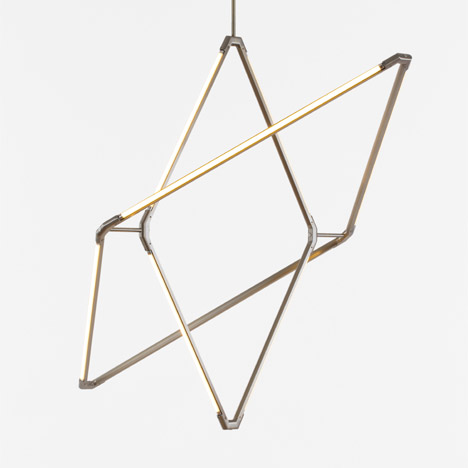
The Shy light still underpins much of her collection. Using a kit of parts, it can be adapted to create a nearly infinite number of configurations for chandeliers, sconces, and table and floor lamps.
Her latest design, Zelda, unveiled at the International Contemporary Furniture Fair, uses a similar tube structure as Shy, but with new connector hardware, so the form is based on diamonds rather than triangles.
"At the end of the day, I'm drawn to lighting because I like the geekery behind it," said Brittain. "But I also love that it's decorative, so I get to make beautiful forms."
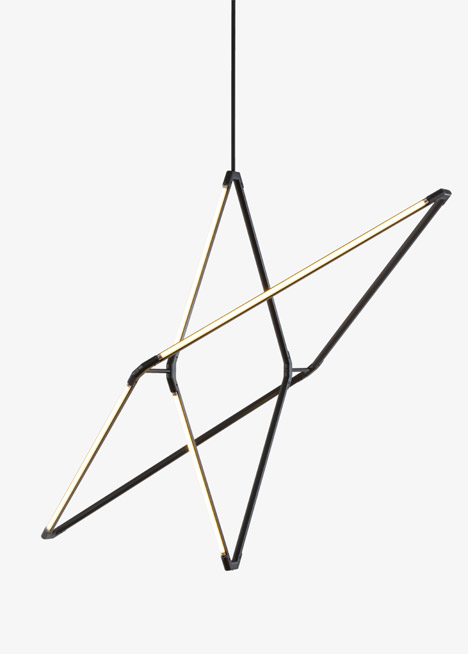
Has her philosophy degree influenced her work? "I think about this a lot," she said. "I do have a cerebral side, and I don't think that's a great place to design from."
"At the end of the day, I'm trying to make pretty things. And so, it actually took a few years after getting out of school to calm that down a bit. It's actually been a process of unlearning and trusting my intuition."
Read an edited version of the transcript from our interview with Bec Brittain:
Jenna McKnight: Can you tell me about your background?
Bec Brittain: I came to be a lighting designer through a windy route. I actually started at Parsons in their product design program. It didn't suit me. I didn't really know why I wanted to make things. I didn't just want to mass produce stuff for the sake of mass producing stuff. And so I took a step back and went to NYU (New York University) for a philosophy degree — to think about design and philosophy and why I'm making stuff. That of course doesn't answer questions; it poses more.
Jenna McKnight: Where did you end up next?
Bec Brittain: I ended up at the Architectural Association in London, which allowed me to read the theory that I like to read, and it allowed me to draw diagrams. It was an amazing boot camp in problem-solving. It's good to be in school and just be thinking about stuff. It really helped me develop a diverse problem-solving skill set — going from a philosophy school to architecture to product design. It gave me a nice, large perspective.
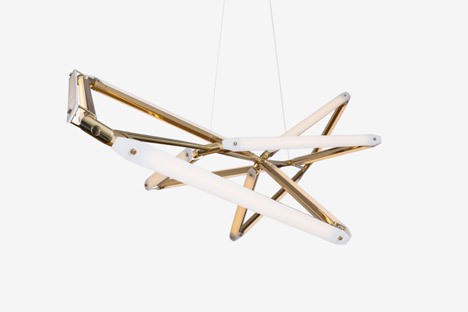
Jenna McKnight: Do you think your understanding of philosophy impacts your designs?
Bec Brittain: I think about this a lot. I do have a cerebral side, and I don't think that's a great place to design from. At the end of the day, I'm trying to make pretty things. And so, it actually took a few years after getting out of school to calm that down a bit. It's actually been a process of unlearning and trusting my intuition.
Jenna McKnight: You have a degree in architecture and worked at New York architecture studio WorkAC. How do you think that influences your designs?
Bec Brittain: Again, I think it's about problem-solving. One of the reasons I left that job is because I realised that I prefer dealing with space on a smaller scale. I don't think I was a particularly good architect.
In product design, I like that my hands are touching everything and I can be in control. Of course we outsource stuff, but it all comes to the studio and we assemble everything ourselves. With architecture, you have to let go of a layer of detail at some point because you have subcontractors. I like the fact that I can be more obsessive with detail on this scale. It's more pragmatic. If you were that obsessive with architecture, you would never get anything built.
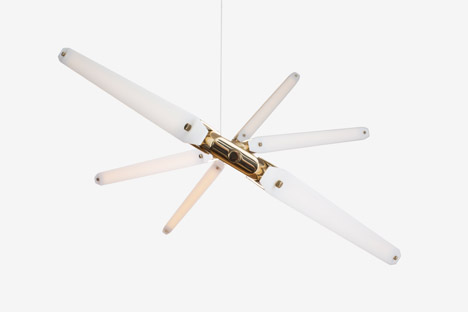
Jenna McKnight: Would you consider yourself a control freak?
Bec Brittain: I used to be more of a perfectionist — it can't go out the door unless it's absolutely perfect. But there's something about running a business where, you know, every single iteration is the very best I can do at the time.
The Shy light hardware was four years ago, and look where it's at now — I've been able to tweak and fine tune. You get better at things, and you get to keep on developing. I'm not a control freak in the way that I understand that perfect doesn't exist.
Jenna McKnight: What are you trying to accomplish with your work – beyond, of course, illuminating a space?
Bec Brittain: I started out with the Shy light. That was the product that launched the business. It was a simple thought I had of wanting to draw with lines of light — of just being as spare as possible. I wanted to use beautiful hardware, but I wanted the piece to be about the lines of light.
That kept me busy for a while. Helix was a riff on using the same hardware but really stripping it down so it was just curves of light. And Echo was a response to wanting to modify the way that light is perceived – it's bounced off of mirrors, so it's softened and multiplied.
At the end of the day, I'm drawn to lighting because I like the geekery behind it. But I also love that it is decorative, so I get to make beautiful forms.
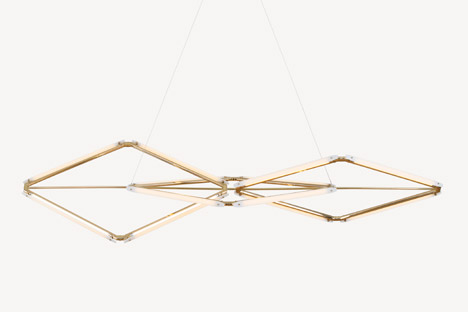
Jenna McKnight: A lot of your designs feature modular components. Why is that?
Bec Brittain: So much of my work – Shy and these new guys, Zelda – is about being iterative. It's a kit of parts. The Shy light can become much, much larger, and it can become site-specific. Zelda is somewhat similar: the diamond is the unit, and we can start to multiply it and keep on building.
Jenna McKnight: Are you interested in the business side of what you do? Or is design your main obsession?
Bec Brittain: I'm beginning to think about my practice a little differently in the past year. There is absolutely one side of it where I am running a business, and it's my livelihood. That is where I am looking at the bottom line and caring about profit and being profitable. But thankfully I'm realising the more that I can grow that, the more opportunity it gives me on this other side to do weirdo commissions or have time to do things that I'm not sure will be commercially viable, but it will get my ideas flowing and get me really excited.
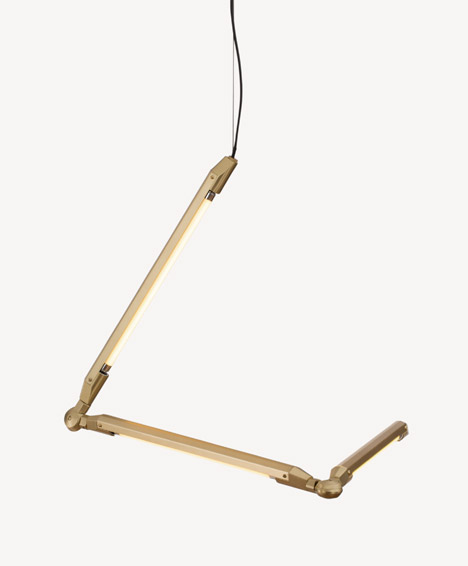
Jenna McKnight: You're based in Bushwick, Brooklyn, which has really changed in recent years. How would you describe Bushwick these days?
Bec Brittain: I don't really recognise Bushwick these days. I don't even know the restaurants because there's a new one every week. I've been there for seven years. I moved there because it was cheap and it was the way I could get a small business off the ground. I'm lucky. It's nicer to live there now. There are places to go, and there's tons of studio space.
Jenna McKnight: Are you planning on opening a studio anywhere else?
Bec Brittain: Well, Lauren, my salesperson, is going to move to LA and she's going to continue working for me. So that might turn into our satellite office. I'm thinking of maybe getting the tiniest storefront ever, so she can have meetings and hang lights. My favourite assembly guy is considering moving to LA, too. So it feels like there might be a satellite office.
Jenna McKnight: What is it like to be a designer in New York right now?
Bec Brittain: It feels like one big happy family a lot of the time. It's nice that we're all friends. There's something exciting about it, because we're always asking each other: "What are you making? And what are you making?" It's rarely competitive. Of course we're all ambitious, but it's a really nice vibe of everyone feeding off each other.
I think there's a stereotypical American sensibility of just wanting to get stuff done, and that is playing out nicely right now. It's really interesting how many designers are actually manufacturing their own stuff, as opposed to licensing to large companies. That feels very American to me. It's exciting — this sort of DIY attitude.
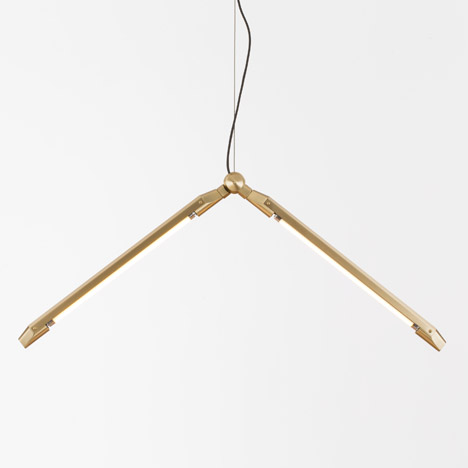
Jenna McKnight: Is it harder here than in Europe to license work to big manufacturers?
Bec Brittain: For me personally, I got into this because I like the making. I like the control I have when I'm manufacturing and I get to make certain decisions that might not be amazing for the bottom line but it's right for the project. I get to be in charge of that. For me it's a personal choice. It's how I want to run my life.
Jenna McKnight: How would you describe the design sensibility here versus Europe or other design markets? Maybe the US is craftier?
Bec Brittain: This question is kind of hard to answer because I'm inside of it. I do recognise to some extent what you're getting at, and I agree. Crafty can be a loaded word — and I don't want to diminish craft either. I think that good American design is a deliberate decision. It is still very finely made. It's not not slick because they couldn't figure out how to make it slick. It's an aesthetic decision, not a lack of design ability.
What I like about American design is that it feels like there is a lot of soul in it. I think you can feel that somebody's hands were on it. And I think – I notice – in a lot of ways there's an influence from the West Coast on East Coast designers. There's a moving away from slick and a moving toward something more soulful and warmer. It's less buttoned-up. I see that going on, and I imagine it's not going on in Europe as much.
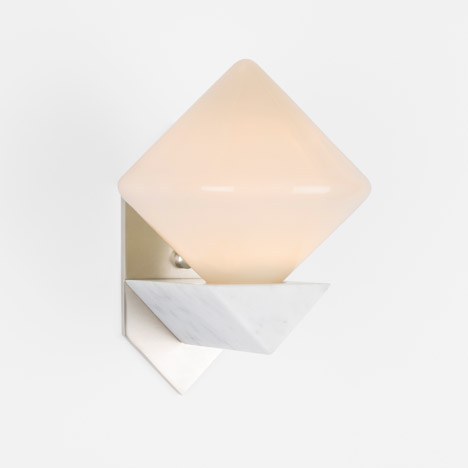
Jenna McKnight: Who would you cite as some of your influences?
Bec Brittain: Definitively Gino Sarfatti, which can be somewhat frustrating because he was so prolific. I'll be working on a sketch and I'll get so excited about it, and then I'll realise he already made it 30 years ago.
To me influence is sort of this nebulous thing. I'm still obsessed with this Japanese armour book after seeing the armour show at the Met. Such amazing colour and material sensibility, and such amazing shapes. So it's not really about being influenced by a designer.
I always have a hard time with that question because who knows where ideas come from. I absolutely know that I'm absorbing ideas from all around me, all the time. What the sponge is picking up is tough to say.